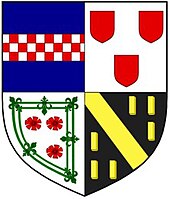Clan Boyd
|
||||||||||||||||||
|
||||||||||||||||||
|
||||||||||||||||||
|
||||||||||||||||||
|
||||||||||||||||||
Boyd is the name of a Scottish clan that originated in the area of the traditional county of Ayrshire . As a clan, he is recognized by the Lord Lyon King of Arms .
history
origin
The name Boyd comes from the Scottish Gaelic word buidh , which can mean either just or yellow .
The founder of the family is said to have been Robert, a nephew of Walter Fitzalan , the first steward of the Kings of Scotland . The genealogist Anderson contradicts this assumption, since Fitzalan was of Norman origin and therefore a Celtic nickname in the family was not to be expected. Historian Black believes that the first Boyds were vassals of the Norman de Morville family on their holdings around Largs and Irvine.
Around 1205 a Robert de Boyd testified to a treaty between the Lord of Eglinton and the free city of Irvine. Another Robert de Boyte can be found on the Ragman Roll (a declaration of allegiance by the Scottish nobles to King Edward I of England ) from 1296.
In 1306 Duncan Boyd was executed for supporting Scottish independence. During the Scottish Wars of Independence Robert Boyd was a devoted supporter of King Robert I 'the Bruce' . As one of the commanders in the Battle of Bannockburn , he was awarded the lands of Kilmarnock, Bodington, and West Kilbride in gratitude for his bravery
The clan chief Sir Robert Boyd was raised to the nobility by King James II with the title Lord Boyd (of Kilmarnock). After Jacob II's death, he was Great Chamberlain of Scotland from 1466 and regent for the young King James III. His son Thomas married Jacob's sister Mary in 1467 and received the title Earl of Arran . In 1469 there was a break with the king. The family of Alexander, a younger brother, was executed. Robert and Thomas were out of the country at this point and remained in exile. All their lands were confiscated and their titles revoked. Mary's marriage was invalidated in 1473 (shortly before Thomas' death).
Robert Boyd, a descendant of the first Lord Boyd, received redress during the reign of Mary Queen of Scots. All titles were granted again, all lands returned. He thanked her for this with fidelity: After Mary's escape from Loch Leven Castle , Lord Boyd was one of the first at her side and fought in the Battle of Langside . He later visited her frequently while in custody in England. He died in 1590.
In the Scottish Civil War between 1644 and 1645, the Boyd clan sided with the royalists. After the Restoration in 1660, William, Lord Boyd was rewarded with the title of Earl of Kilmarnock .
William Boyd, 3rd Earl of Kilmarnock, opposed the First Jacobite Rising and led a regiment of Ayrshire volunteers on behalf of the government. His son William, 4th Earl of Kilmarnock, supported the Second Jacobite Rebellion and fought alongside Bonnie Prince Charlie in the Battle of Culloden after he was appointed general. Boyd was captured in the battle, then taken to the Tower of London and executed by beheading on August 18, 1746. His titles Earl of Kilmarnock and Lord Boyd lapsed. His eldest son, James, was not involved in the uprising and was entitled to the title of Earl of Erroll through his mother's line . He changed his last name to Hay in 1758 when he followed his great-aunt Mary as Earl of Erroll.
The title of Baron Kilmarnock was given in 1831 to William Hay, 18th Earl of Erroll, as an additional and subordinate title to the Earl. This gave him a seat in the House of Lords that was otherwise unrelated to Scottish dignity.
The clan today
Josslyn Victor Hay, 22nd Earl of Erroll, died in Kenya in 1941. His daughter inherited the earl dignity, but the title of baron and the dignity of chief of Clan Boyd may only be passed on in the male line. So this title and this dignity passed to the younger brother Gilbert Allan Rowland Hay, who became 6th Baron Kilmarnock and changed his last name to Boyd in the same year.
Robin Jordan Boyd is currently the 8th Baron Kilmarnock and thus the hereditary clan chief of Clan Boyd.
Nobility title
Members of the clan lead or carried the following nobility titles:
- Earl of Arran (1467)
- Earl of Kilmarnock (1661)
- Earl of Erroll (1452)
- Lord Hay (1430)
- Lord Slains (1452)
- Lord Boyd (1454)
- Baron Kilmarnock (1831)
- Baron Boyd of Duncansby (Life Peer, 2006)
- Boyd Baronet, of Danson Hill (1775)
- Boyd Baronet, of Howth House (1916)
Clan castles
- Dean Castle , seat of the chief of Clan Boyd until 1975.
- Bedlay Castle , owned by Clan Boyd until 1642, then sold to Clan Robertson .
- Brodick Castle
- Callendar House
- Law Castle
- Little Cumbrae Castle
- Penkill Castle
- Portencross Castle
- Slains Castle
- Trabboch Castle
- Pitcon Castle, demolished and replaced by a mansion in the 18th century.
literature
- George Way, Romilly Squire: Collins Scottish Clan & Family Encyclopedia . HarperCollins, New York 1994, ISBN 0-00-470547-5 .
Web links
- House of Boyd Society. Retrieved September 23, 2014 .
- The Standing Council of Scottish Chiefs. Retrieved September 23, 2014 .
Individual evidence
- ↑ Septs & surnames. House of Boyd Society, accessed September 23, 2014 (list of associated families).
- ^ Way, Squire: Collins Scottish Clan & Family Encyclopedia. 1994, p. 76.


